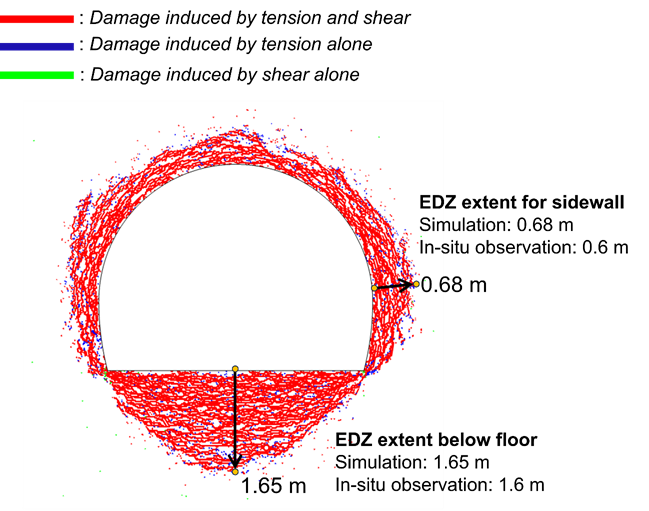Realistic analysis of excavation damaged zone trends in an underground research lab in Japan
Published 11 October, 2023
To ensure the effectiveness of high-level radioactive waste (HLW) disposal facilities, the distribution of hydraulic and mechanical properties within the surrounding rock mass, acting as a natural barrier, should be evaluated. To achieve this, it is essential to predict the distribution of the excavation damaged zone (EDZ), which forms due to the creation of multiple fractures during the excavation of the radioactive waste disposal cavity. This is because such a zone is expected to cause an increase in permeability and a decrease in the stiffness and strength of the rock mass.
For precise prediction of the unknown EDZ distribution in specific underground conditions, a numerical analysis should be used. This analysis should have a proven track record of replicating EDZ trends observed in pre-in-situ tests conducted under similar conditions. To enhance reliable predictions for EDZ distribution in HLW disposal projects worldwide, it is advantageous to compile well-calibrated numerical analysis examples from representative underground research areas in each country, such as underground research laboratories (URLs). In the case of one of Japan's prominent research sites, the Horonobe URL, however, there have been limited attempts to replicate EDZ trends through numerical analysis.
In a recent study published in the KeAi journal Rock Mechanics Bulletin, Assistant Professor Sho Ogata of Osaka University and Professor Hideaki Yasuhara from Kyoto University introduced a novel numerical analysis. This analysis successfully replicates the observed EDZ trends resulting from niche excavation within the Horonobe URL gallery at a depth of 350 meters.
“Our findings indicate that the simulated results not only closely align with the measured EDZ data in terms of extent, but also accurately depict the fracture failure modes observed during in-situ examinations,” explained Ogata. “A key factor contributing to this high level of reproducibility compared to measured results is the advanced capability of their numerical analysis to concurrently solve rock deformation and fracturing.”
Their approach addresses the simultaneity of the two-way interaction between rock deformation and fracture generation, a vital aspect often overlooked in conventional numerical analyses dealing with rock fracture generation. Not solving this interaction completely simultaneously can result in deviations from the actual mechanical responses of rocks during excavation.
“Considering that sedimentary rocks, particularly mudstone, constitute a significant portion of Japan's geological landscape, this numerical investigation of the Horonobe URL, where mudstone prevails, holds substantial relevance and applicability in assessing the viability of geological disposal of high-level radioactive waste (HLW) in Japan,” added Yasuhara.

Contact author details: Sho Ogata, Center for Future Innovation, Graduate School of Engineering, Osaka University, Japan, ogata@civil.eng.osaka-u.ac.jp
Funder: This work was supported by the JST FOREST Program (Grant no. JPMJFR216Y, Japan) and JSPS KAKENHI (Grant nos. 20K14826, 22H01589, and 22H00229).
Conflict of interest: The authors declare that they have no known competing financial interests or personal relationships that could have appeared to influence the work reported in this paper.
See the article: Sho Ogata and Hideaki Yasuhara., Numerical simulations for describing generation of excavation damaged zone: Important case study at Horonobe underground research laboratory, Rock Mechanics Bulletin, Volume 2, Issue 3, 2023, 100063, https://doi.org/10.1016/j.rockmb.2023.100063